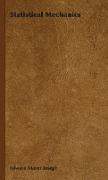- Start
- Statistical Mechanics
Statistical Mechanics
Angebote / Angebote:
STATISTICAL MECHANICS by JOSEPH EDWARD MAYER. Published in 1940. PREFACE: The rapid increase, in the past few decades, of knowledge concerning the structure of molecules has made the science of statistical mechanics a practical tool for interpreting and correlating experimental data. It is therefore desirable to present this subject in a simple manner in order to make it easily available to scientists whose familiarity with theoretical physics is limited. This book, which grew out of lectures and seminars given to graduate students in chemistry and physics, aims to fulfill this purpose. The development of quantum mechanics has altered both the axio matic foundation and the details of the methods of statistical mechanics. Although the results of a large number of statistical calculations are un affected by the introduction of quantum mechanics, the chemists interest happens to be largely in fields where quantum effects are im portant. Consequently, in our presentation, the laws of statistical mechanics are founded on the concepts of both quantum and classical mechanics. The equivalence of the two methods has been stressed, but the quantum-mechanical language has been favored. We believe that this introduction of quantum statistics at the beginning simplifies rather than puts a burden upon the initial concepts. It is to be emphasized that the simpler ideas of quantum mechanics, which are all that is used, are as widely known as the more abstract theorems of classical mechanics which they replace. Simplicity of presentation rather than brevity and elegance has been our endeavor. However, we have not consciously sacrificed rigor. Care has been taken to make the book suitable for reference by sum marizing and tabulating final equations as well as by an attempt to make individual chapters complete in themselves without too much reference to previous subjects. All the theorems and results of mechanics and quantum mechanics which are used later have been summarized, largely without proof, in Chapter 2. The last section, 2k, on Einstein-Bose and Fermi-Dirac systems, ties up closely with Chapters 5 and 16 only. Chapters 3 and 4 contain the derivation of the fundamental statistical laws on which the book is based. Chapter 10 is prerequisite for Chapters 11 to 14. Otherwise, individual subj ects may be taken up in different order. In Chapters 7 to 9 considerable space is devoted to the calculation of thermodynamic functions for perfect gases, which was considered justi fied by the value of the results for the chemist. These chapters may be omitted by readers uninterested in the subject. Chapters 13 and 14 on the imperfect gas and condensation theory, respectively, are somewhat more complicated than the remainder, but are included because of our special interest in the subject. The aim of the book is to give the reader a clear understanding of principles and to prepare him thoroughly for the use of the science and the study of recent papers. Many of the simpler applications are dis cussed in some detail, but in general language without comparison with experiment. The more complicated subjects have been omitted, as have been those for which at present only partial solutions are obtained. This choice has excluded many of the contemporary developments, especially the interesting work of J. G. Kirkwood, L. Onsager, H. Eyring, and W, F. Giauque. In conclusion we express our gratitude to Professors Max Born, Karl F. Hcrzfeld, and Edward Teller, who have read and criticized several parts of the manuscript. We also thank Dr. Elliot Montroll, who aided in reading proof and who made many helpful suggestions.
Folgt in ca. 15 Arbeitstagen
